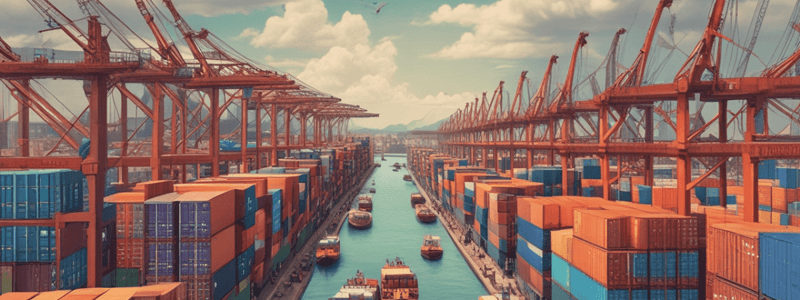Podcast
Questions and Answers
What is the main difference between export agents and EMCs?
What is the main difference between export agents and EMCs?
- EMCs handle the sale and handling of goods more effectively than export agents.
- EMCs provide more limited services compared to export agents.
- Export agents have more control over distribution channels than EMCs.
- Export agents focus on specific countries, while EMCs provide worldwide coverage. (correct)
What advantage does direct exporting have over indirect exporting?
What advantage does direct exporting have over indirect exporting?
- Greater control over distribution channels and marketing. (correct)
- Indirect exporting allows for leveraging home government support.
- Direct exporting requires dealing with a large number of individual contacts.
- Direct exporting requires less financial resources than indirect exporting.
Which is a reason companies may choose foreign production as an entry strategy?
Which is a reason companies may choose foreign production as an entry strategy?
- To maintain control over international sales and marketing.
- To increase import tariffs.
- To avoid currency fluctuation risks.
- To reduce transportation costs. (correct)
What does licensing involve?
What does licensing involve?
What is a disadvantage of licensing as an entry strategy?
What is a disadvantage of licensing as an entry strategy?
What is unique about franchising compared to licensing?
What is unique about franchising compared to licensing?
What category of local manufacturing involves an international company arranging for products to be manufactured by an independent local company?
What category of local manufacturing involves an international company arranging for products to be manufactured by an independent local company?
What is the first market entry strategy mentioned in the text?
What is the first market entry strategy mentioned in the text?
Which company's progression to a more involved market entry strategy is used as an example in the text?
Which company's progression to a more involved market entry strategy is used as an example in the text?
In indirect exporting, where is the intermediary typically located?
In indirect exporting, where is the intermediary typically located?
What is a disadvantage of wholly owned subsidiaries?
What is a disadvantage of wholly owned subsidiaries?
What does an Export Management Company (EMC) take care of in export operations?
What does an Export Management Company (EMC) take care of in export operations?
Which ownership strategy involves a foreign parent firm fully owning operations in the host country?
Which ownership strategy involves a foreign parent firm fully owning operations in the host country?
What role can an Export Management Company (EMC) play in the export process?
What role can an Export Management Company (EMC) play in the export process?
Which of the following is NOT mentioned as a responsibility of an Export Management Company (EMC)?
Which of the following is NOT mentioned as a responsibility of an Export Management Company (EMC)?
What is a common cause of dissolution for Joint Ventures (JVs)?
What is a common cause of dissolution for Joint Ventures (JVs)?
In indirect exporting, what does a Trading House do?
In indirect exporting, what does a Trading House do?
What is a key advantage of Strategic Alliances?
What is a key advantage of Strategic Alliances?
In Mergers & Acquisitions, what is a disadvantage that businesses for sale often have?
In Mergers & Acquisitions, what is a disadvantage that businesses for sale often have?
Which market entry strategy involves selling to a Trading House based in the exporter's home country?
Which market entry strategy involves selling to a Trading House based in the exporter's home country?
Which market entry strategy has a low degree of ownership and control, but a high extent of investment and risk?
Which market entry strategy has a low degree of ownership and control, but a high extent of investment and risk?
What is a common disadvantage of Joint Ventures (JVs) as discussed in the text?
What is a common disadvantage of Joint Ventures (JVs) as discussed in the text?
Which type of relationship between firms involves sharing research & development expertise, as described in the text?
Which type of relationship between firms involves sharing research & development expertise, as described in the text?
What is a potential cause of 'JV Divorce' mentioned in the text?
What is a potential cause of 'JV Divorce' mentioned in the text?
Which market entry strategy involves the purchase of an established business that continues to operate independently or becomes integrated with the purchaser?
Which market entry strategy involves the purchase of an established business that continues to operate independently or becomes integrated with the purchaser?
What is a significant challenge associated with Wholly Owned Subsidiaries, as mentioned in the text?
What is a significant challenge associated with Wholly Owned Subsidiaries, as mentioned in the text?
Flashcards are hidden until you start studying
Study Notes
Indirect Exporting
- Indirect exporting involves using an intermediary located in the exporter's home country.
- Intermediaries include Export Management Companies (EMCs) and Export Agents.
- EMCs manage all aspects of export operations (4Ps) and can act as merchants or agents.
- Export Agents assist manufacturers in exporting goods, providing limited services, and focusing on one country or part of the world.
Direct Exporting
- Direct exporting involves selling directly to customers or through intermediaries located in the foreign market.
- Advantages: greater control over distribution channels and marketing, leveraging home government support, knowledge of foreign market conditions, and readily available expertise.
- Disadvantages: requires dealing with a large number of individual contacts, significant financial resources and management time, and loss of direct control.
Foreign Production as an Entry Strategy
- Reasons for foreign production include saving costs, eliminating import tariffs, reducing currency fluctuation risks, and communicating commitment to the local market.
- Forms of foreign production include licensing, franchising, and local manufacturing (contract manufacturing, assembly, and full-scale integrated production).
Licensing
- Licensing involves assigning the right to a copyright or patent and/or trademark to another company for a fee or royalty.
- Advantages: low investment way to enter a new market, licenses are time-bound, and complete dependence on local licensee to produce revenue/royalties.
- Disadvantages: revenue is dependent on marketing skills of the local company, uncertainty of product quality, and management time to train licensees.
Franchising
- Franchising is a special type of licensing where the company makes a total marketing plan available, including brand name, logo, products, and methods of operation.
- Examples include "master franchises" - rights to market within a city, country, or region of the world.
Local Manufacturing
- Contract manufacturing involves an international company arranging to have its products manufactured by an independent local company on a contractual basis.
- Assembly involves an international company locating a portion of manufacturing in a foreign company, typically the last stage of the manufacturing process.
- Full-scale integrated production involves a fully integrated local production unit, requiring significant capital investment.
Ownership Strategies
- Wholly Owned Subsidiaries: operations in the host country are fully owned by a foreign parent firm, involving marketing, assembly, or full-scale integrated production operations.
- Advantages: foreign parent firms establish the strategy, keeping all profits, and easier integration into a global network.
- Disadvantages: oversight, management, and training are required to ensure strategy is executed, and not allowed in all markets/countries.
Joint Ventures
- Joint ventures involve an outside partner sharing stock ownership in the "new unit", often from the host country.
- Advantages: alternative in markets/countries where subsidiaries are not permitted, allows for quick, lower investment entry into market(s), and shared political risks.
- Disadvantages: may be difficult to find willing partners, higher failure rate, and potential for JV divorce.
Strategic Alliances
- Strategic alliances involve relationships between firms that exceed a simple sales transaction but stop short of a full-scale merger.
- Examples include technology-based, production-based, and distribution-based alliances.
Mergers and Acquisitions
- Mergers and acquisitions involve the purchase of an established business that continues to run independently or becomes an integrated part of the purchasing origination.
- Advantages: immediate market share/presence, no need to build manufacturing and distribution from scratch, and overcome government challenges.
- Disadvantages: businesses for sale often have problems, and local competition could purchase first to block international companies.
Global Market Entry Strategies
- There is a trade-off between the degree of ownership and control (low to high) and the extent of investment and risk required (low to high) for each entry mode.
- Companies trade off risk and return when choosing among these market entry strategies, often beginning with a form of exporting and progressing to a more involved market entry strategy.
Studying That Suits You
Use AI to generate personalized quizzes and flashcards to suit your learning preferences.





